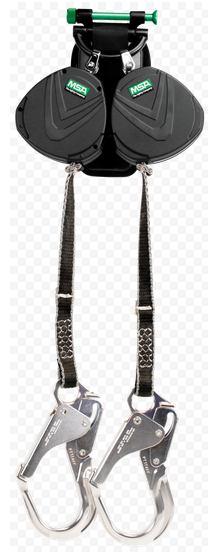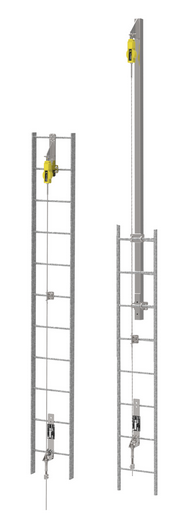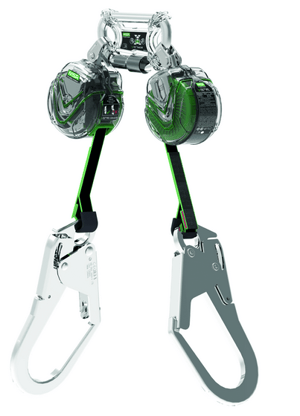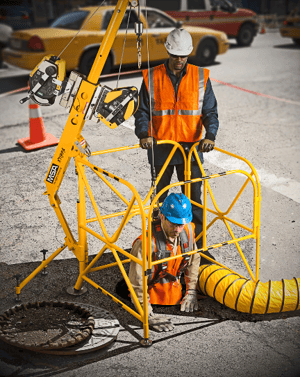The Latest In Fall Protection... Andy Speidel of MSA Safety on "Roco Chats With the Experts"
Pat Furr (Roco Rescue): Good morning Andy and thanks so much for joining us today.
Andy Speidel (MSA): Oh, it’s my pleasure Pat. Thanks for inviting me.
PF: We’re going to talk about all things Fall Protection. We’ll cover the latest advances in equipment and talk about how they’ve impacted how we work at height. We’ll also touch on some recent and upcoming regulatory changes, get your take on ways readers might be able to improve their fall protection programs, and discuss how to work effectively with a safety equipment rep.
AS: Sounds great, Pat.
The Latest Innovations in Fall Protection Equipment
PF: MSA is a leader in the design and manufacture of fall protection equipment and systems, so tell us about the latest advances in equipment that may just make the end user’s job easier and safer all at once.
AS: The last several years have seen significant advances in the use of modern design and manufacturing techniques as well as the use of lighter and stronger materials such as aircraft aluminum and synthetic fibers. This has allowed  manufacturers to innovate and come up with products that are lightweight, easy to employ, multi-functional, and most importantly, these products are appealing to the authorized person, which ultimately encourages them to use it.
manufacturers to innovate and come up with products that are lightweight, easy to employ, multi-functional, and most importantly, these products are appealing to the authorized person, which ultimately encourages them to use it.
Our design team has put a lot of emphasis on making our harnesses more intuitive to don. The new lightweight materials we use make it possible to not only meet all the standards, but also to provide superior comfort, flexibility and adjustability - which ultimately allows the user to more easily don the harness.
PF: Of all the latest and greatest pieces of kit, which ones jump out as the most exciting for you?
AS: We’ve taken a huge step forward with our personal fall limiters (PFLs)  through the use of Kevlar and Dyneema rope, which gives them the strength and abrasion resistance to be used in leading edge applications, while at the same time making them much lighter than earlier generations that used wire rope. Additionally, the interface allows the PFL to be used on a variety of harnesses. It’s a simple aluminum pin that slides through a web loop on the harness to make the connection.
through the use of Kevlar and Dyneema rope, which gives them the strength and abrasion resistance to be used in leading edge applications, while at the same time making them much lighter than earlier generations that used wire rope. Additionally, the interface allows the PFL to be used on a variety of harnesses. It’s a simple aluminum pin that slides through a web loop on the harness to make the connection.
PF: One of the scariest scenes I encounter when doing site visits are these Frankenstein, cobbled together horizontal lifelines. Some of them would struggle to hold up the laundry, let alone arrest a fallen worker.
AS: Horizontal lifelines must be designed, inspected and installed under the supervision of a qualified person, which I am willing to bet, some of the ones you’ve seen were not. We at MSA, as well as a few other manufacturers, are producing user-installable, pre-engineered temporary horizontal lifeline systems. These systems are typically constructed of wire or synthetic rope. They come in a variety of lengths and are very easy to deploy and recover. We have a unique system where two workers  on the same horizontal lifeline can easily bypass each other without having to disconnect. This allows increased mobility and decreases worker interference while still maintaining 100% fall protection.
on the same horizontal lifeline can easily bypass each other without having to disconnect. This allows increased mobility and decreases worker interference while still maintaining 100% fall protection.
PF: I would imagine these systems include comprehensive user instructions that mandate the anchor strength requirements and detail clearance requirements?
AS: That is correct. The instructions outline the parameters for use and include calculations for clearance requirements based on the span of the line between anchors, the number of workers on the system, and the type of lanyard they’re using to connect. Our systems have either a turnbuckle or a pulley tensioning system, making it very easy to adjust the sag for the proper tightness of the line.
Equipment Advances Provide New Options For Re-Thinking Work-At-Height With The Hierarchy of Fall Protection In Mind
PF: One of the things that I see with the better fall protection equipment manufacturers is that they truly make an effort to educate the competent and qualified persons as well as the program administrators on their options for not only providing a safe and compliant solution for their employees, but also on appealing to the authorized persons. I think the big three for end users are lightweight, ease of use, and multifunctional. When you make a site visit or a presentation, it must be gratifying to see the light bulbs go on as your attendees hear the options available to them.
AS: It is and although my job entails selling equipment, I don’t approach my visits with ‘making a sale’ as my primary objective. I want to hear from the potential customer what their needs are and what their big concerns are.
PF: Are there any common themes in those discussions?
AS: Many people assume a fall arrest system is the only solution, when really we ought to take a step back and approach the problem using the hierarchy of fall protection. It’s not always possible, but quite often there’s a solution on a lower step of the hierarchy that restrains a worker from falling, or that brings some of the work to the ground – which is usually the safest solution.
PF: That reminds me of an exercise I often do when I’m presenting on fall protection or giving a talk at a conference. I ask everyone in the audience to close their eyes and visualize whatever comes to mind as I state two words: fall protection. Then I ask them what they were visualizing.
AS: Let me guess… they say harness and fall arrest lanyard.
PF: Yep, those are the most common answers.
AS: That’s why it’s important for us to listen to the customer, assess their situation, and discuss solutions that work best for their application and provide the least amount of risk to the worker. For example, we have a lot of customers who need to regularly access a flat roof on an older structure with no perimeter guardrails or parapets. When I tell them about retrofitting guardrails such as our VersiRail system, they worry about the costs. When we discuss other options such as active restraint or even fall arrest systems and the time it takes to set up and the limited mobility they often provide, they start to see the advantages of a passive fall protection system which doesn’t require authorized person training or specialized equipment. And compared to the average cost for one fatal incident, let alone the tragedy of such an occurrence, suddenly the cost for a perimeter guardrail system sounds affordable.
However, for those who still can’t justify the cost, we do have non-penetrating temporary anchors that work great on flat roofs for both active restraint and fall arrest anchors. Our Constant Force Post is one such example.
Ways To Improve Your Fall Protection Program
PF: What do you see as a less obvious deficiency in fall protection programs beyond the more common shortfalls such as general lack of compliance?
AS: One area that’s often overlooked is the need to read and understand the instructions for use for equipment and systems. This information is essential to ensure correct and safe usage. Not all SRLs are designed for leading edge applications. Not all personal fall limiters can be mounted at foot level. Even something as simple as proper fit of a full body harness varies from harness to harness. That’s why I encourage employers and fall protection program owners to work with a manufacturer who can help them standardize their equipment and provide follow-up support and training.
PF: That’s definitely a concern. Do you have any others that you would like to address?
AS: Greater focus on authorized person pre-use inspections. Unfortunately, OSHA only requires an annual periodic inspection be performed by a competent person for most fall protection equipment. Some systems such as horizontal lifelines need to be inspected by a qualified person. MSA recommends periodic inspection by a competent person on most pieces of equipment at 6-month intervals and depending on environmental conditions and type of wear and tear the equipment is exposed to, it can be even more frequent. We count on the authorized persons doing a thorough pre-use inspection, but often these are not being done as they should.
PF: Oh I agree 100%. I’ve seen some downright scary equipment that had no business being used on the job. My suggestion for program administrators: have your authorized persons perform the pre-use inspection on their coworker’s kit and vice versa. Nobody likes to get called out for having failed to do their job, so trading harnesses so that I inspect yours while you inspect mine creates an incentive to make sure yours is in serviceable condition.
Retrieval Self-Retracting Lifelines: A Primer
PF: I'd like to hear your thoughts on a piece of equipment that many end users are either unaware of, or don’t fully understand its capabilities. I'm talking about a retrieval self-retracting lifeline (RSRL).
AS: RSRLs are great in specific applications. Sometimes we are confronted with multiple hazards as defined by OSHA and ANSI. For instance, we may have a significantly high vertical entry into a permit required confined space. This involves at least two different OSHA regulations and requires certain protections as mandated by those different regs. We need to protect the entrant from the fall hazard and have a means of retrieving the entrant in the event of an emergency. In the case of the confined space regulation, if the vertical entry is greater than 5’, then the retrieval system must be a mechanical means of retrieval that is of sufficient hauling ability to lift the entrant up and out of the space. RSRLs satisfy both needs by providing fall arrest and retrieval capability.
PF: What types of anchors or anchor systems do you recommend for RSRLs in order to support a vertical confined space entrant?
AS: A tripod is a good choice, but for situations where there’s limited space, or some other obstruction that prevents the use of a tripod, the MSA Xtirpa system is a great way to mount either the RSRL or a straight winch system. It’s easy to set up and extremely lightweight. It’s compatible with a large assortment of mounting systems such as the manhole collar shown below, ballasted cantilever mounts, floor bolted mounts and many other options.
Regulatory Changes: OSHA’s Walking and Working Surfaces
PF: Let’s talk about the changes to the OSHA Walking and Working Surfaces regulation and specifically the changes to fixed vertical ladders and the shift to vertical ladder safety systems as a move away from cages and wells. What are the options for employers to retrofit these systems (without getting into the mandated timeline issues)?
AS: We have two primary ways these systems can be installed.  The first way is we can come out and install it for you, whether it’s one of our kits or it’s a custom-built system. For all applications greater than 90’, we facilitate an MSA-authorized installer to perform the installation. The second way is if a customer purchases one of our kits, they can opt to handle the installation themselves. We have kits up 90’, so they cover a lot of applications. All that’s really needed are some basic mechanical skills and the ability to follow the instructions provided within the user’s manual.
The first way is we can come out and install it for you, whether it’s one of our kits or it’s a custom-built system. For all applications greater than 90’, we facilitate an MSA-authorized installer to perform the installation. The second way is if a customer purchases one of our kits, they can opt to handle the installation themselves. We have kits up 90’, so they cover a lot of applications. All that’s really needed are some basic mechanical skills and the ability to follow the instructions provided within the user’s manual.
PF: I really think ladder cages are a poor solution for worker safety. I certainly wouldn’t want to fall through a ladder cage and get hung up in it. I can only imagine the horrific injuries that would result. I’m glad that OSHA has decided to make them obsolete, but I’m concerned that many employers will wait until 2036 approaches before making the move to a safer system.
AS: I agree and share your concern, Pat. Another way to meet compliance is to use a top mount davit with an SRL and tagline. This solution is an option when evaluating a vertical ladder safety system. Some companies go with this option because they’re easy to install and don’t require the user to have a front chest d-ring on their harness.  Another option would be to use a twin leg personal fall limiter and clip along from rung to rung.
Another option would be to use a twin leg personal fall limiter and clip along from rung to rung.
Fall Protection in Residential Roofing
PF: You and I have worked together in the past up in your neck of the woods, presenting information to a variety of groups on fall protection equipment. As more safety managers see these new systems and equipment, they are very apt to provide a safer yet more user-friendly solution to their authorized workers. However, we are still seeing a particular segment of the construction industry lagging in providing compliant fall protection for their workers. That industry is residential construction and in particular residential roofing.
AS: Yes, residential roofing is clearly a segment that needs us to demonstrate that there are great solutions that not only keep their employees safe, but also make it easier for workers to do their jobs. I remember a recent conference where you had a steep angle roofing mock set up, and seeing the smiles on the faces of attendees when they realized they could let their harness support their weight instead of trying to curl their toes and hold onto the sheathing while laying felt. I think for most of them it was quite a revelation. I believe you had two different systems set up. The positioning system was simply a 5/8” lifeline with a short shock-absorbing lanyard attached to a manual rope grab. And on the other exposure you had a temporary horizontal lifeline along the peak with a leading edge SRL attached to it.
PF: Yes, but the SRL was not just any SRL. It was your V-Edge Leading Edge SRL.
AS: Yes, it was great to see the attendees’ reactions as the V-Edge followed their movement along the horizontal lifeline. In addition to the leading edge feature of that particular SRL, it also has a built-in roll-cage around the clear cable housing which allows the entire unit to pivot around a floor mounted anchor. This keeps the direction of pull or tension of the cable directly in line with the user and SRL. It works great on steep angle roofs attached to a horizontal lifeline to keep the device aligned vertically with the user as they move about the roof.
Viewing Your Safety Equipment Rep As A Resource To Help Solve For Safety Concerns
PF: There’s certainly a lot of innovation happening in the fall protection equipment market. How do you recommend employers think about worker safety in the context of these new technologies?
AS: I think it’s a high return on investment exercise for employers to invite safety equipment representatives into their facility to look at different applications, almost like an audit. A good equipment rep specializes in staying on top of all the latest developments in the dynamic world of equipment and safety systems. It’s tough for an employer to do that on their own, so the safety equipment rep ideally will partner with the employer to evaluate all their concerns and help them prioritize. I’ve found employers are often pleasantly surprised with the solutions folks like me come up with, either because they didn’t think a solution existed, or because they were surprised we could make the workplace safer without impeding production.
PF: Andy, I want to thank you for having this chat with Roco Rescue and I know we have just scratched the surface of everything fall protection. I hope our readers have found this both informative and entertaining, and perhaps got them thinking about their own fall protection needs.
AS: Thanks so much for inviting me to join you today Pat. We at MSA want to ensure employers are armed with all the information they need to select the fall protection equipment and systems that best suit their needs. We love talking about how our products can be used in various applications, but most importantly how they can be used to ensure workers make it home safely.










